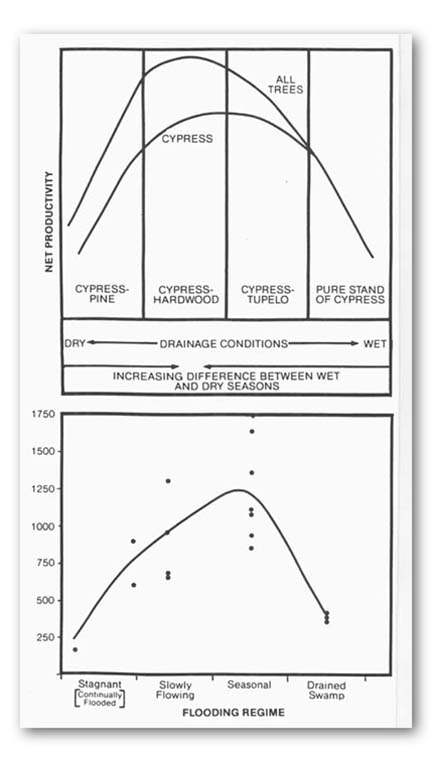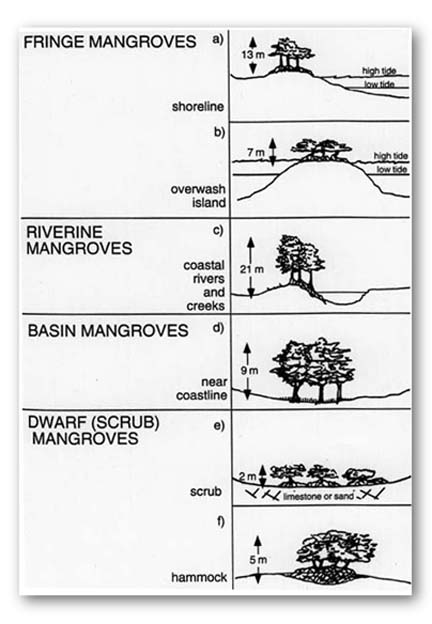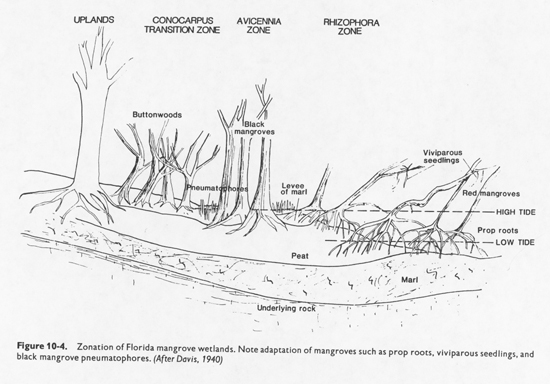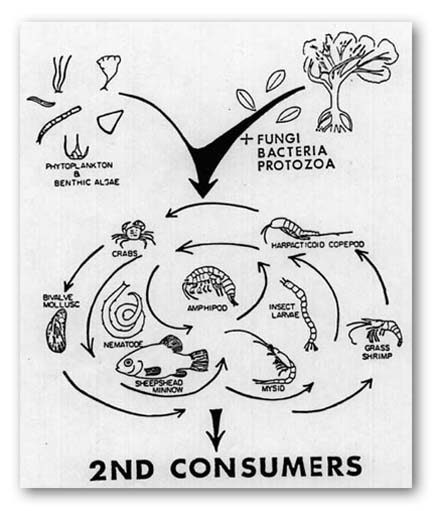Return to Week 4- Lecture 1
Return to overhead index
RELATIONSHIP BETWEEN PRODUCTIVITY
AND HYDROLOGY
 FIG 13-5. The relationship of cypress swamp productivity
and hydrologic conditions.( from Mitsch and Ewel, 1979 cw 1979 by American
Midland Naturalists.)
FIG 13-5. The relationship of cypress swamp productivity
and hydrologic conditions.( from Mitsch and Ewel, 1979 cw 1979 by American
Midland Naturalists.)
Return to Week 4- Lecture 1
Return to overhead index

Return to Week 3 - Lecture 2
Return to overhead index
MAJOR TYPES OF MANGROVE WETLANDS
 FIG. 10-2. Classification of mangrove wetlands according
to hydrodynamic conditions. General classification is a & b) fringe
mangroves; c) riverine mangroves; d) basin mangroves; and e & f) scrub
(dwarf) mangroves.)After Wharton et al., 1976; Lugo 1980, and Clintron et
al., 1985.)
FIG. 10-2. Classification of mangrove wetlands according
to hydrodynamic conditions. General classification is a & b) fringe
mangroves; c) riverine mangroves; d) basin mangroves; and e & f) scrub
(dwarf) mangroves.)After Wharton et al., 1976; Lugo 1980, and Clintron et
al., 1985.)
Return to Week 4- Lecture 1
Return to overhead index
ZONES OF MANGROVE VEGETATION
 FIG 10-4. Zonation of Florida mangrove wetlands. Note
adaptation of mangroves such as prop roots, viviparous seedlings, and black
mangrove pneumatophores.(After Davis, 1940)
FIG 10-4. Zonation of Florida mangrove wetlands. Note
adaptation of mangroves such as prop roots, viviparous seedlings, and black
mangrove pneumatophores.(After Davis, 1940)
Return to Week 4- Lecture 1
Return to overhead index
MANGROVE WETLANDS
ECOSYSTEM FUNCTIONS
Productivity
dependent on tidal / runoff factors
-Highest in riverine
-lower in basin
-lowest in dwarf
Marsh
is a producer of detritus for river and adjacent estuary
- Riverine @ 94% export of organic litter
-Basin @ 21% export of organic litter
Detrital
decomposition is the major pathway for energy utilization
Transformer
of nutrients
Marsh
provides benthic, aquatic, and avian habitat
Return to Week 4- Lecture 1
Return to overhead index
ENERGY FLOW IN A MANGROVE
 Fig 10-8. Detritus-based food web in south Florida estuary
showing the major contribution of mangrove detritus.(From W.E. Odum 1970,
p. 140).
Fig 10-8. Detritus-based food web in south Florida estuary
showing the major contribution of mangrove detritus.(From W.E. Odum 1970,
p. 140).
Return to Week 4- Lecture 1
Return to overhead index

Return to Week 3 - Lecture 2
Return to overhead index

Return to Week 3 - Lecture 2
Return to overhead index

